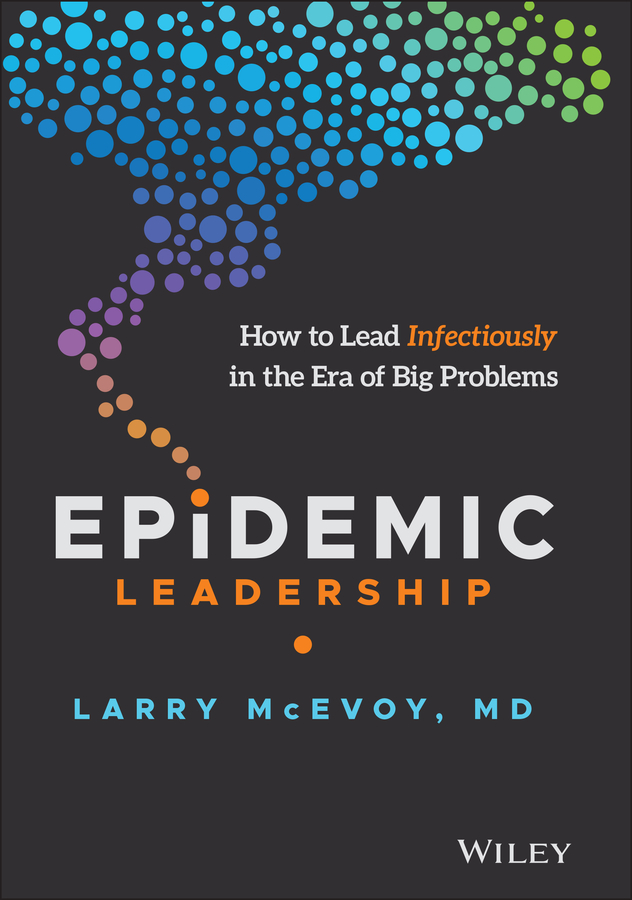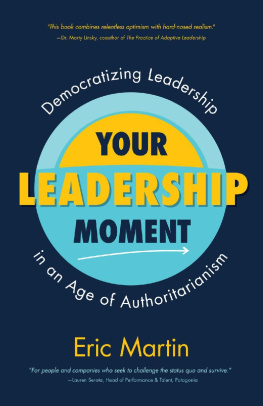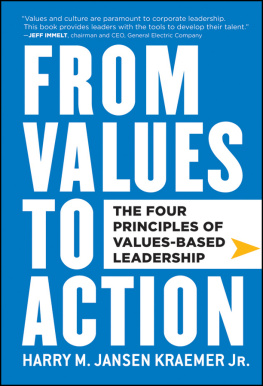
Table of Contents
List of Tables
- Chapter 6
- Chapter 11
List of Illustrations
- Chapter 6
- Chapter 9
Guide
Pages
How to Lead Infectiously in the Era of Big Problems
Epidemic Leadership
LARRY McEVOY, MD

Copyright 2021 by John Wiley & Sons, Inc. All rights reserved.
Published by John Wiley & Sons, Inc., Hoboken, New Jersey.
Published simultaneously in Canada.
No part of this publication may be reproduced, stored in a retrieval system, or transmitted in any form or by any means, electronic, mechanical, photocopying, recording, scanning, or otherwise, except as permitted under Section 107 or 108 of the 1976 United States Copyright Act, without either the prior written permission of the Publisher, or authorization through payment of the appropriate per-copy fee to the Copyright Clearance Center, Inc., 222 Rosewood Drive, Danvers, MA 01923, (978) 750-8400, fax (978) 646-8600, or on the Web at www.copyright.com. Requests to the Publisher for permission should be addressed to the Permissions Department, John Wiley & Sons, Inc., 111 River Street, Hoboken, NJ 07030, (201) 748-6011, fax (201) 748-6008, or online at http://www.wiley.com/go/permissions.
Limit of Liability/Disclaimer of Warranty: While the publisher and author have used their best efforts in preparing this book, they make no representations or warranties with respect to the accuracy or completeness of the contents of this book and specifically disclaim any implied warranties of merchantability or fitness for a particular purpose. No warranty may be created or extended by sales representatives or written sales materials. The advice and strategies contained herein may not be suitable for your situation. You should consult with a professional where appropriate. Neither the publisher nor author shall be liable for any loss of profit or any other commercial damages, including but not limited to special, incidental, consequential, or other damages.
For general information on our other products and services or for technical support, please contact our Customer Care Department within the United States at (800) 762-2974, outside the United States at (317) 572-3993 or fax (317) 572-4002.
Wiley publishes in a variety of print and electronic formats and by print-on-demand. Some material included with standard print versions of this book may not be included in e-books or in print-on-demand. If this book refers to media such as a CD or DVD that is not included in the version you purchased, you may download this material at http://booksupport.wiley.com. For more information about Wiley products, visit www.wiley.com.
Library of Congress Cataloging-in-Publication Data is Available:
ISBN 9781119787457 (Hardcover)
ISBN 9781119787471 (ePDF)
ISBN 9781119787464 (ePub)
Cover Design: Wiley
Cover Image: Courtesy of LCI Group, LLC
For the joyous crowds, the great herds, the endless flocks, the teeming schools (of fish and children), and all whose goodness incubates in obscurity ahead of coming abundance
Introduction
When I started writing this book, epidemics didn't hold the attention of many people beyond epidemiologists and risk-policy wonks. Then, COVID-19 hit. By a freak of timing, I found myself writing as the pandemic ended hundreds of thousands of lives, closed our schools and workplaces, crashed the global economy, monopolized the daily news cycle, and drove us out of the open and into hiding, from our parks and streets and deeper into our screens and phones. Like all of us, I watched as the spread of a brainless virus exploited our societal divisions and inequalities, exposed the inadequacy of leadership and supply lines, and tilted a presidential election. A microscopic clump of genetic material enveloped in proteins made the reality of epidemics a palpable threat and an urgent teacher. It challenged our notions of command and control over our environment and opened the possibilities around what leading must become in a changed and changing world.
I write from my perspective as a doctor and particularly as an emergency physician. My clinical career began as a medical student at Stanford University and took root in the garden of pathology we call the emergency department during my residency at Hennepin County Medical Center in Minneapolis. I learned the highly specialized skills that allowed me to diagnose, treat, and resuscitate patients whose unpredictable palette of disease, distress, and destruction flowed into my workplace every day, night, and weekend. Over the course of my clinical career, I learned to find a sense of ease amid the chaos of lives abruptly unhinged from the illusion of normal. I learned that high-trust team intelligence outpaced disconnected expertise. I learned that all the algorithms and protocols in the world don't equip us to match the way disease and illness multiply in our populations, a reality our health care personnel recognized only too well from the strain on them during this most recent pandemic.
I also write from the perspective of an executive who has worked with hundreds of leaders and teams over the course of my career. I had the opportunity to help an emergency department and two health care organizations work their way through duress and subpar performance to results both objectively demonstrated and subjectively immeasurable. As the CEO of my state's largest trauma center, I watched several thousand people turn an entire organization around when it was listing badly during the national financial meltdown of 2008 (and when cynics predicted our inevitable collapse). Perhaps befitting an emergency physician and others who find themselves facing the braver work of leadership, I have always worked and learned in places where what used to work doesn't anymore, where people are trying hard and wearing out, and where hope is essential and hard to find.
We live in such times and places today. We have too much to do and not enough time to do it. Our technology ambiguously speeds things along and rushes us so fast we can't think straight. Our models of organization, leadership, and governance are breaking down, or at least groaning and cracking, under the weight of problems that are large, complex, and interconnected. Our world, whether we measure it in divisiveness, environmental degradation, or the vitality of our workplaces and communities, grows unhealthier and more stressed. The future arrives and beckons our response, yet we resist. Leaders have to grapple with all these things in a way that enables people to deliver better results, to learn relentlessly, and to re-energize and reconnect. Somehow those things have to happen not once, not in a few places, but repetitively, everywhere.
Along came coronavirus, specifically SARS-CoV-2, an obscure idea of a germ morphed into a worldwide infectious, political, social disruption with catastrophic and fracturing consequences. No more hiding. It's in our face, here and real. It has threatened our bodies, rattled our minds, split our towns and neighborhoods, and shocked our systems. More quietly, it has asked us if we're ready, really ready, to accept a present reality that invites a powerful shift to a better future.
Epidemics represent and expose the scientific principles underlying networks, complex systems, biology, and, in the case of humans, neurobiology. Such disciplines are rife with research, complex mathematical and statistical formulations, and underlying concepts of physics and biology that can be bewildering. This book is not meant to be an in-depth scientific exegesis. Instead, it is intended as an invitation to think about leading with a new framework, a framework that unfolds into simple, accessible concepts and techniques that leaders can put to work wherever they are to create both individual participation and collective wisdom in a world where scaling both stability and adaptability has become non-negotiable.
Next page








